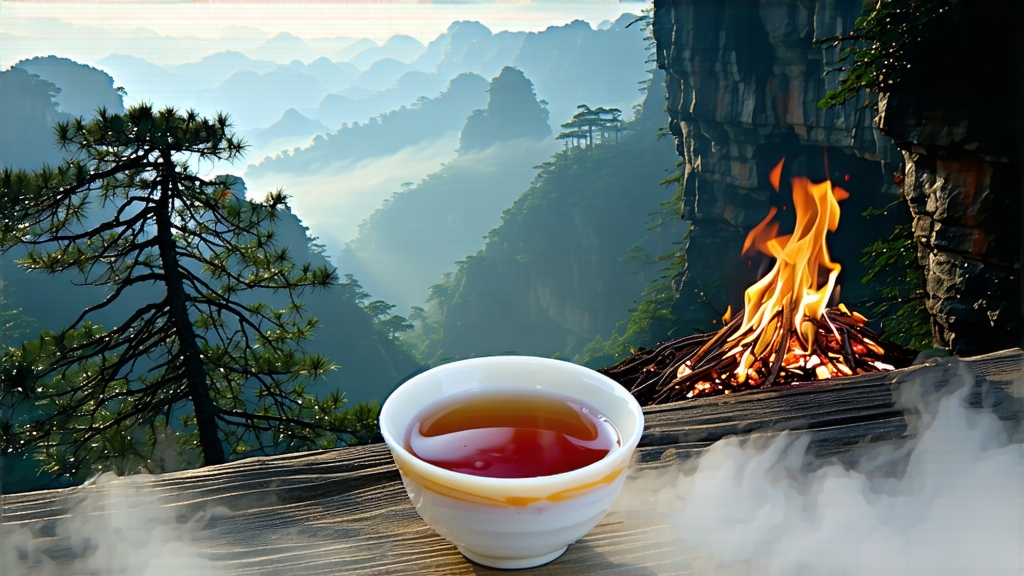
If every tea has a passport, Lapsang Souchong’s is stamped with the soot of pine needles and the salt spray of the Min River. Born in the Wuyi Mountains of northern Fujian, this rugged black tea is the oldest recorded of its kind, the primogenitor that taught the world what “red tea” could taste like. When Dutch merchants unloaded the first chests on European quays in 1604, drinkers had never encountered a leaf so dark, a liquor so crimson, or a scent so suggestive of distant camp-fires. In the centuries that followed, Lapsang Souchong became both muse and commodity: it inspired the smoky blends of Earl Grey, financed the porcelain trade, and still anchors the benchmark for Chinese black tea on every cupping table from Hamburg to Hobart.
Yet the name itself is a miniature map. “Souchong” refers to the fourth and fifth leaves of the tea bush—broad, mature blades once considered too coarse for the green teas that Song-dynasty poets adored. “Lapsang” is an anglicization of Lei Xun, the village that clings to Tongmu Guan, a narrow pass where mist, altitude and resinous Chinese red pine (Pinus massoniana) conspire to create a micro-climate no larger than 120 square kilometres. Inside this UNESCO buffer zone the original cultivars—Xiao Ye Zhong (small-leaf) and the rarer Ye Sheng (wild)—grow slowly on mineral-rich, weathered tuff, storing aromatic oils that later surrender to smoke with uncanny grace.
Strictly speaking, only leaf processed within this protected gorge may bear the name Zheng Shan Xiao Zhong, “Original Mountain Small Sort.” Everything else is waishan, outside-mountain tea, often bulk-smoked for export and unfairly maligned as “tar in a cup.” The distinction matters, because authentic Lapsang Souchong is not a blunt instrument of creosote; it is a layered dialogue between leaf, fire and time.
Harvest begins in late April, after the Wuyi night rain has rinsed the bamboo leaves and the morning fog sits waist-deep. Pluckers take one bud and two leaves only on windless days so that the surface moisture can evaporate naturally during the 3–4 hour withering phase. Bamboo trays rest on racks inside a three-storey wooden house whose top floor is perforated like a Chinese lantern; rising warm air desiccates the leaf without bruising it. Once the blades feel leathery—soft enough to twist but not crack—they are rolled 40 minutes on rattan mats, a slower rhythm than the mechanised maceration of Assam, preserving cellular integrity so that oxidation proceeds evenly.
Oxidation is the heart-beat that turns green leaf black. In Tongmu it is still done the Ming way: rolled leaves are heaped in deep bamboo baskets, covered with wet cotton cloths, and left in a draught-free room kept at 24 °C and 80 % humidity. Three to four hours later the grassiness has vanished, replaced by the scent of ripe apricot and wet copper. A quick 90-second blast of 200 °C heat in iron woks arrests the enzyme, locking in a mahogany colour that will later glisten like lacquer.
Now comes the step that scandalises the uninitiated: smoking. But there is finesse here. A trench dug into the packed-earth floor is filled with embers of three-year-old pine logs that have been stripped of bark to reduce resin spikes. The smouldering wood never flames; it sighs. A bamboo lattice topped with oxidised leaf is slid across the pit, and the tea is smoked for 30–40 minutes, then rested, then smoked again, up to eight cycles. Master smokers judge readiness by ear: when the pine crackle softens to a maternal hush, the leaf has absorbed just enough terpenes to suggest rosemary, longan and cured bacon without masking its own honeyed sweetness.
The final bake is a low 70 °C for six hours, reducing moisture to 3 % and fusing smoke to cell walls so that the aroma will not volatilise during the month-long sea voyage still favoured by traditional exporters. When cool, the leaf is sorted by hand on bamboo trays where elderly women shake the trays with a wrist motion that mimics calligraphy strokes; fragments fall through, leaving only whole, wiry strips that